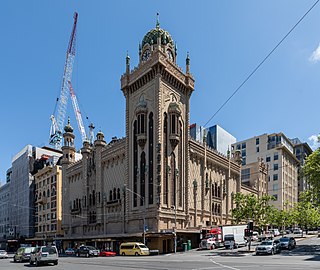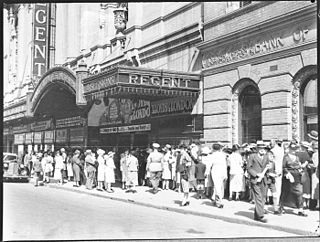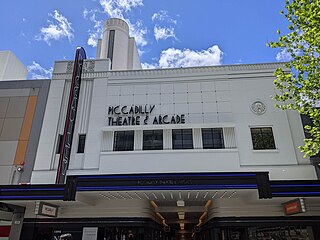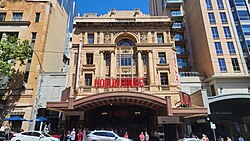
Francis William Thring IV was an Australian character actor in radio, stage, television and film; as well as a theatre director. His early career started in London in theatre productions, before he starred in Hollywood film, where he became best known for roles in Ben-Hur in 1959 and King of Kings in 1961. He was known for always wearing black and styling his home in black decor.

Rundle Mall is a pedestrian street mall located in Adelaide, South Australia. It was opened as a pedestrian mall in September 1976 by closing the section of Rundle Street between King William Street and Pulteney Street, to vehicular traffic. The street continues as Rundle Street to the east and Hindley Street to the west.

The Grand Theatre, also known as Leeds Grand Theatre and Leeds Grand Theatre and Opera House, is a theatre and opera house in Briggate, Leeds, West Yorkshire, England. It seats approximately 1,500 people.

The Forum Theatre is a historic theatre and former cinema now used as a live music and event venue located on the corner of Flinders Street and Russell Street in Melbourne, Australia.

The Regent Theatre was a heritage-listed cinema and entertainment venue in George Street, Sydney, New South Wales, Australia, built in 1928 as a flagship for Hoyts, and was demolished in 1988 by property developer Leon Fink.

Melbourne Central is a large shopping centre, office, and public transport hub in the central business district of Melbourne, Victoria, Australia. The main tower is 211-metre (692 ft) high, making it one of the tallest buildings in Melbourne at the time it was built in 1991. Other parts of the complex include the Melbourne Central Shopping Centre, the underground Melbourne Central railway station and the heritage-listed Coop's Shot Tower.

The Regent Theatre is a theatre in Dunedin, New Zealand with a seating capacity of about 1,650. It is in The Octagon, the city's central plaza, directly opposite the Municipal Chambers and close to the Dunedin Public Art Gallery.

The Princess Theatre, originally Princess's Theatre, is a 1452-seat theatre in Melbourne, Victoria, Australia. Established in 1854 and rebuilt in 1886 to a design by noted Melbourne architect William Pitt, it is the oldest surviving entertainment site on mainland Australia. Built in an elaborate Second Empire style, it reflects the opulence of the "Marvellous Melbourne" boom period, and had a number of innovative features, including state of the art electric stage lighting and the world's first sliding ceiling, which was rolled back on warm nights to give the effect of an open-air theatre.

The Palais Theatre, formerly known as Palais Pictures, is a historic picture palace located in St Kilda, an inner suburb of Melbourne, Victoria, Australia. With a capacity of nearly 3,000 people, it is the largest seated theatre in Australia.

Regent Theatre was a heritage-listed cinema at 167 Queen Street, Brisbane, Australia. It was designed by Richard Gailey, Charles N Hollinshed and Aaron Bolot and built from 1928 to 1929 by J & E L Rees and A J Dickenson. It was one of the original Hoyts' Picture Palaces from the 1920s. It is also known as Regent Building. The auditorium interior was largely lost when it was converted into a 4 screen complex in 1979–1980, but the building, including the surviving entrance and main foyer, was added to the Queensland Heritage Register on 21 October 1992.

The Everyman, also referred to as the Everyman Theatre and historically known as the Everyman Palace, is a 650-seat Victorian theatre on MacCurtain Street in Cork, Ireland. It opened in 1897, and is the oldest purpose-built theatre building in Cork. The theatre is housed in a protected Victorian building with a large stage and auditorium, a proscenium arch, four elaborately decorated boxes, a studio space and a bar.

The former Plaza Theatre in Sydney, New South Wales is a heritage-listed building designed as a 2000-seat cinema by Eric Heath for the Hoyts Group, and opened in 1930. It is no longer used as a cinema.

The Palace Theatre was an entertainment venue located in Melbourne, Australia. First built for live theatre in 1912, it was also used as a cinema and for live music. It was demolished except for its facade in 2020 after much community opposition, to be replaced by a hotel.
The Regal Theatre, formerly known as the Chelsea Cinema, the Princess Theatre and the Ozone Marryatville or Marryatville Ozone Theatre, is a single-screen cinema in Kensington Park, a suburb of Adelaide, South Australia. Originally built in 1925 to the designs of South Australian theatre architect Christopher Arthur Smith, it retains the features of a major renovation in Art Deco style in 1941 designed by noted cinema architect F. Kenneth Milne. It was heritage-listed on the South Australian Heritage Register in 1983. It is the oldest continuously running purpose-built cinema in Adelaide, and the only remaining silent cinema still operating in the city. It is owned by Burnside Council.

The Piccadilly Cinema Centre and Piccadilly Arcade are located at 700-704 Hay Street, Perth, Western Australia. It is an art deco style cinema and shopping arcade, designed by architect William T. Leighton for mining entrepreneur Claude de Bernales. The theatre and arcade opened in 1938, with the arcade connecting Hay Street through to Murray Street.

Francis William Thring III, better known as F. W. Thring, was an Australian film director, producer, and exhibitor. He has been credited with the invention of the clapperboard.

The former Plaza Theatre is located at 650–658 Hay Street, Perth, Western Australia. It was the first purpose-designed Art Deco cinema in Perth. The Plaza Theatre opened in 1937 and was built for Hoyts Theatres Ltd.

Henry Eli White, also known as Harry White, was a New Zealand-born architect best known for the many theatres and cinemas he designed in New Zealand and Australia in the 1910s and 1920s. Many of the major surviving historic venues in the two countries are White designs, including the St. James Theatre, Wellington, St. James Theatre, Auckland, the Capitol Theatre and State Theatre in Sydney, and the Palais Theatre and the interiors of the Princess Theatre and Athenaeum Theatre in Melbourne. He also designed the City Hall and the attached Civic Theatre in Newcastle, New South Wales.
David Marriner is an property developer and theatre owner, based in Melbourne, Australia.

Roxy Theatre is a heritage-listed former theatre at 65–69 George Street, Parramatta, City of Parramatta, New South Wales, Australia. It was designed by Moore & Dyer in association with Herbert & Wilson. It is also known as Roxy Spanish Theatre, Hoyts Roxy Centre, Village Roxy 3 and The Roxy. It was added to the New South Wales State Heritage Register on 2 April 1999.


















